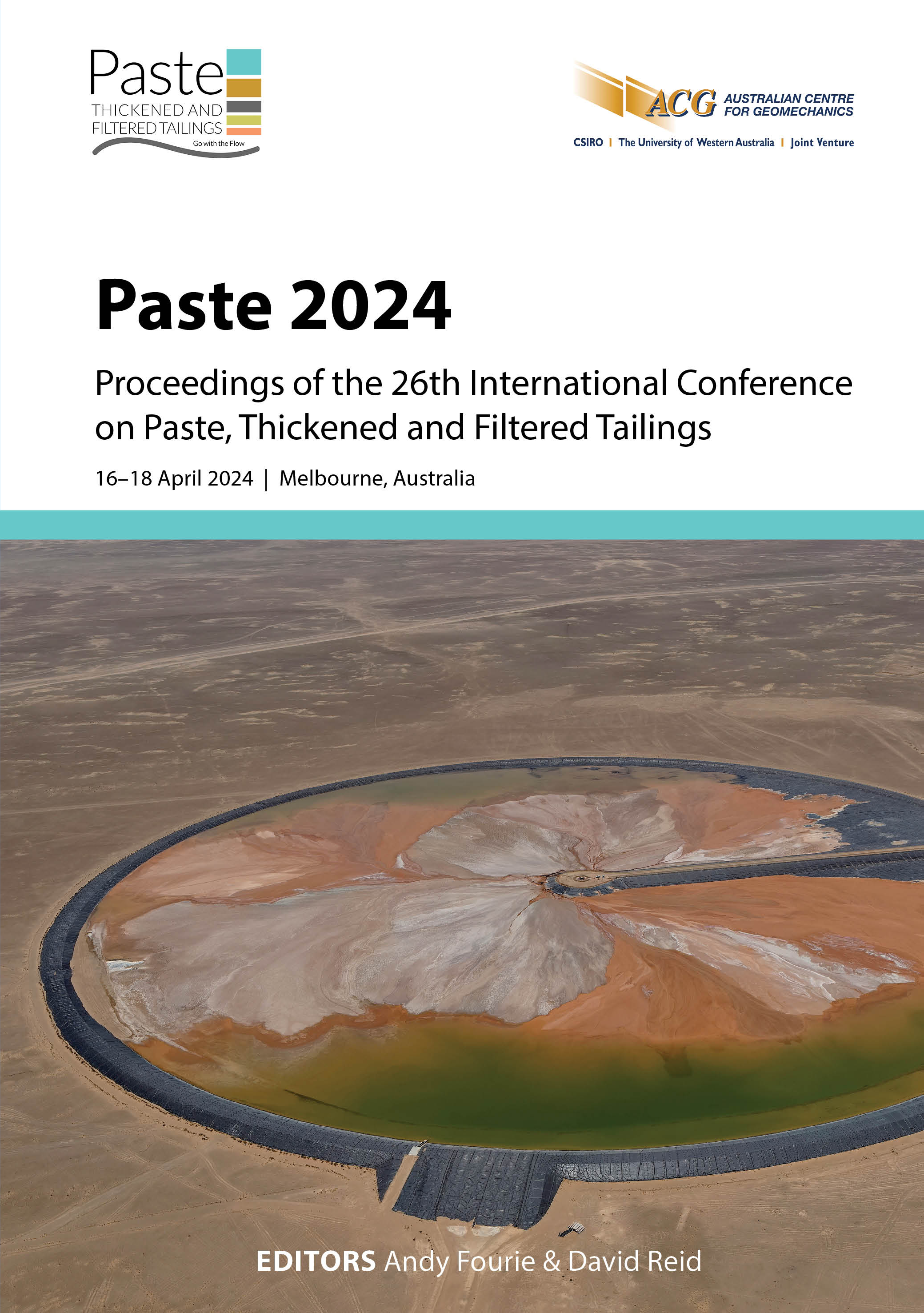Development of slag alternatives for paste backfill operations

|
Authors: Romaniuk, NA; McFarlane, L; Hariharan, N |
DOI https://doi.org/10.36487/ACG_repo/2455_42
Cite As:
Romaniuk, NA, McFarlane, L & Hariharan, N 2024, 'Development of slag alternatives for paste backfill operations', in AB Fourie & D Reid (eds), Paste 2024: Proceedings of the 26th International Conference on Paste, Thickened and Filtered Tailings, Australian Centre for Geomechanics, Perth, pp. 535-544, https://doi.org/10.36487/ACG_repo/2455_42
Abstract:
Paste backfilling, a critical step of the underground mining cycle which enables both increased resource recovery and provides a resilient tailings storage solution, is increasingly challenged by limited availability of industrial byproduct binders such as ground granulated blast furnace slag (GGBFS). The use of high quality GGBFS has proven to be critical for operators to address challenges posed by unique and complex ore compositions such as high sulphate ores while also contributing towards reducing the scope 3 greenhouse gas (GHG) emissions, especially as traditional cement binders can be responsible for up to 70% of the GHG emissions in the backfill process. This paper focuses on the development of a versatile engineered lime-based binder for paste backfill which maintains a low GHG footprint and can be made adaptable to various mine conditions, such as high sulphate ores, without compromising strength and other performance requirements. The novel binder has been tested in laboratory conditions by monitoring the unconfined compressive strength development over time using a sulphate-rich paste tailings provided by a commercial mining operation in Canada and has shown promising progress as a slag alternative.
Keywords: paste fill, paste backfill, sulphate, GHG reduction, binder, slag alternative
References:
Azadi, M, Northey, SA, Ali, SH & Edraki, M 2020, ‘Transparency on greenhouse gas emissions from mining to enable climate change mitigation’, Nature Geoscience, vol. 13, no. 2, pp.100–104.
Azevedo, M, Baczynska, M, Bingoto, P & Callaway, G 2022, The Raw-Materials Challenge: How the Metals and Mining Sector Will be at the Core of Enabling the Energy Transition, McKinsey & Company, viewed 20 November 2023,
Belem, T & Benzaazoua, M 2004, ‘An overview on the use of paste backfill technology as a ground support method in cut-and-fill mines’, in E Villaescusa & Y Potvin (eds), Ground Support 2004: Proceedings Fifth International Symposium on Ground Support in Mining and Underground Construction, Australian Centre for Geomechanics, Perth, pp. 637–650.
Benzaazoua, M, Belem, T & Bussière, B 2002, ‘Chemical factors that influence the performance of mine sulphidic paste backfill’, Cement and Concrete Research, vol. 32, no. 7, pp. 1133–1144.
Harris, P, Scullion, T & Sebesta, S 2004, Hydrated Lime Stabilization of Sulfate-bearing Soils in Texas, FHWA Technical Report no. FHWA/TX-04/0-4240-2, Texas Department of Transportation, Austin.
International Council on Mining and Metals 2023, Scope 3 Emissions Accounting and Reporting Guidance, viewed 20 November 2023,
Kawai, K, Sugiyama, T, Kobayashi, K & Sano, S 2005, ‘Inventory data and case studies for environmental performance evaluation of concrete structure construction’, Journal of Advance Concrete Technology, vol. 3, no. 3, pp. 435–456.
Patchell, J 2018, ‘Can the implications of the GHG Protocol's scope 3 standard be realized?’, Journal of Cleaner Production, vol. 185, pp. 941–958.
Portland Cement Association 2021, Environmental Product Declaration: Portland Cement, viewed 20 November 2023,
oct2023.pdf?sfvrsn=88aefebf_2
Qi, C & Fourie, A 2019, ‘Cemented paste backfill for mineral tailings management: review and future perspectives’, Minerals Engineering, vol. 144, p.106025.
Safari, A & Lim, H 2023, ‘The benefit of delithiated beta spodumene to reduce the carbon footprint of cemented paste backfill’, in GW Wilson, NA Beier, DC Sego, AB Fourie & D Reid (eds), Paste 2023: Proceedings of the 25th International Conference on Paste, Thickened and Filtered Tailings, University of Alberta, Edmonton, and Australian Centre for Geomechanics, Perth, pp. 82–97,
Slag Cement Association 2020, An Industry Average Environmental Product Declaration for Slag Cement, viewed 20 November 2023,
Seymour, LM, Maragh, J, Sabatini, P, Di Tommaso, M, Weaver, JC & Masic, A 2023, ‘Hot mixing: mechanistic insights into the durability of ancient Roman concrete’, Science Advances, vol. 9, no. 1, pp. 1602.
Sheshpari, M 2015, ‘A review of underground mine backfilling methods with emphasis on cemented paste backfill’, Electronic Journal of Geotechnical Engineering, vol. 20, no. 13, pp.5183–5208.
Tariq, A & Yanful, EK 2013, ‘A review of binders used in cemented paste tailings for underground and surface disposal practices’, Journal of Enviromental Management, vol. 131, pp 138–149.
mcs2023/mcs2023-iron-steel-slag.pdf
Walker, R & Pavía, S 2011, ‘Physical properties and reactivity of pozzolans, and their influence on the properties of lime–pozzolan pastes’, Materials and Structures, vol. 44, pp. 1139–1150.
Williams, DJ 2021, ‘Lessons from tailings dam failures—where to go from here?’, Minerals, vol. 11, no. 8, p.853.
© Copyright 2025, Australian Centre for Geomechanics (ACG), The University of Western Australia. All rights reserved.
View copyright/legal information
Please direct any queries or error reports to repository-acg@uwa.edu.au
View copyright/legal information
Please direct any queries or error reports to repository-acg@uwa.edu.au
